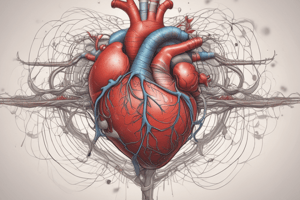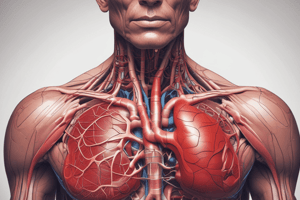Podcast
Questions and Answers
What is primarily responsible for regulating blood flow at the local level?
What is primarily responsible for regulating blood flow at the local level?
- Valves in veins
- Vascular smooth muscle (correct)
- Cardiac output
- Elastic tissues
Veins cannot collapse while arteries remain open.
Veins cannot collapse while arteries remain open.
False (B)
What is the primary effect of the Frank-Starling mechanism on cardiac output?
What is the primary effect of the Frank-Starling mechanism on cardiac output?
It increases cardiac output by allowing the heart to pump more effectively based on the volume of blood filling the heart.
The _______ is responsible for maintaining basal vascular tone.
The _______ is responsible for maintaining basal vascular tone.
Which of the following is a key factor in determining preload?
Which of the following is a key factor in determining preload?
Match the following terms with their descriptions:
Match the following terms with their descriptions:
Parasympathetic nerves are involved in vasoconstriction.
Parasympathetic nerves are involved in vasoconstriction.
What role do valves in veins play concerning venous return?
What role do valves in veins play concerning venous return?
Which of the following factors can influence venous return?
Which of the following factors can influence venous return?
The Frank-Starling mechanism state that an increased preload leads to an increased stroke volume.
The Frank-Starling mechanism state that an increased preload leads to an increased stroke volume.
What is the main effect of afterload on cardiac output?
What is the main effect of afterload on cardiac output?
The_____________ nervous system plays a crucial role in regulating heart rate and contractility.
The_____________ nervous system plays a crucial role in regulating heart rate and contractility.
Match the following terms with their definitions:
Match the following terms with their definitions:
Which of the following conditions can cause oedema?
Which of the following conditions can cause oedema?
Fenestrated capillaries are found only in the liver and spleen.
Fenestrated capillaries are found only in the liver and spleen.
What is one consequence of lymphatic dysfunction?
What is one consequence of lymphatic dysfunction?
What does CO stand for in the context of the cardiovascular system?
What does CO stand for in the context of the cardiovascular system?
In heart failure, the amount of blood entering the ventricle during diastole decreases involuntarily.
In heart failure, the amount of blood entering the ventricle during diastole decreases involuntarily.
What mechanism helps the heart cope with variations in venous return?
What mechanism helps the heart cope with variations in venous return?
Increased TPR leads to increased ______ for the same cardiac output.
Increased TPR leads to increased ______ for the same cardiac output.
Match the following terms with their descriptions:
Match the following terms with their descriptions:
Which factors can augment the preload on the heart?
Which factors can augment the preload on the heart?
The sympathetic nervous system decreases heart rate and contractility.
The sympathetic nervous system decreases heart rate and contractility.
What hormone is important in preventing blood pressure from becoming too low during heart failure?
What hormone is important in preventing blood pressure from becoming too low during heart failure?
Blood flow to the arteries during ventricular systole is referred to as ______.
Blood flow to the arteries during ventricular systole is referred to as ______.
Match the following responses with their triggers:
Match the following responses with their triggers:
Which of the following describes the condition when venous return is effectively less than normal?
Which of the following describes the condition when venous return is effectively less than normal?
The baroreceptor reflex plays a role in regulating heart rate and blood pressure.
The baroreceptor reflex plays a role in regulating heart rate and blood pressure.
What is the primary determinant of afterload?
What is the primary determinant of afterload?
During isovolumetric contraction, the ventricles ______ without changing their volume.
During isovolumetric contraction, the ventricles ______ without changing their volume.
Flashcards
Cardiac Cycle Phases
Cardiac Cycle Phases
The four phases of the heart's pumping action: atrial filling, rapid ventricular filling, diastasis (slower ventricular filling), and atrial systole, followed by ventricular systole.
Cardiac Output (CO)
Cardiac Output (CO)
The amount of blood pumped by the heart per minute, calculated as Stroke Volume (SV) multiplied by Heart Rate (HR).
Venous Return (VR)
Venous Return (VR)
The amount of blood flowing back into the heart's ventricles during diastole.
Preload
Preload
Signup and view all the flashcards
Frank-Starling Mechanism
Frank-Starling Mechanism
Signup and view all the flashcards
Afterload
Afterload
Signup and view all the flashcards
Total Peripheral Resistance (TPR)
Total Peripheral Resistance (TPR)
Signup and view all the flashcards
Heart Failure
Heart Failure
Signup and view all the flashcards
Baroreceptors
Baroreceptors
Signup and view all the flashcards
Sympathetic Nervous System
Sympathetic Nervous System
Signup and view all the flashcards
Parasympathetic Nervous System
Parasympathetic Nervous System
Signup and view all the flashcards
Stroke Volume (SV)
Stroke Volume (SV)
Signup and view all the flashcards
Atrial Systole
Atrial Systole
Signup and view all the flashcards
Venous Capacitance
Venous Capacitance
Signup and view all the flashcards
Left Ventricular End-Diastolic Pressure (LVEDP)
Left Ventricular End-Diastolic Pressure (LVEDP)
Signup and view all the flashcards
Vicious Cycle of Heart Failure
Vicious Cycle of Heart Failure
Signup and view all the flashcards
Elastic Arteries
Elastic Arteries
Signup and view all the flashcards
Vascular Smooth Muscle Tone
Vascular Smooth Muscle Tone
Signup and view all the flashcards
Resistance Vessels
Resistance Vessels
Signup and view all the flashcards
Vasoconstriction
Vasoconstriction
Signup and view all the flashcards
Blood Redistribution
Blood Redistribution
Signup and view all the flashcards
Vasodilation
Vasodilation
Signup and view all the flashcards
Myogenic Response
Myogenic Response
Signup and view all the flashcards
Artery/Vein Response
Artery/Vein Response
Signup and view all the flashcards
Capillaries
Capillaries
Signup and view all the flashcards
Vein Collapse
Vein Collapse
Signup and view all the flashcards
Oedema Causes
Oedema Causes
Signup and view all the flashcards
Venous Valves
Venous Valves
Signup and view all the flashcards
Hydrostatic Pressure
Hydrostatic Pressure
Signup and view all the flashcards
Oncotic Pressure
Oncotic Pressure
Signup and view all the flashcards
Lymphatic System
Lymphatic System
Signup and view all the flashcards
Oedema Types
Oedema Types
Signup and view all the flashcards
Study Notes
Cardiovascular System Overview
- Circulation is cyclical movement, orderly movement in a circuit
- Blood circulates oxygen and removes carbon dioxide
- Transports nutrients to cells and removes waste
- Protects against disease and infection
- Stops bleeding with clotting
- Regulates body temperature
Fluid Distribution in the Body
- Body is approximately 60% water
- Two-thirds of body water is intracellular
- One-third is extracellular, consisting mostly of interstitial fluid
- Blood plasma is part of the extracellular fluid (25%)
- Plasma makes up 55% of whole blood
- Blood cells make up 45% of whole blood
Blood Vessel Structure & Function
- Vessel diameters vary greatly, from 30 mm (vena cava) to 7-8 µm (capillaries).
- Flow rate is proportional to the fourth power of the radius
- Flow is inversely proportionate to viscosity
Blood Pressure & Flow
- Blood pressure drops most significantly across arterioles.
- Average blood pressure = 120/70 mmHg
- Pressure in pulmonary arteries = 25/10 mmHg
- Elastic tissues in elastic arteries allow continuous flow & prevent damage.
Vascular Tone & Regulation
- Vascular smooth muscle maintains basal tone, affecting blood pressure and flow
- Systemic factors include vasoconstriction (adrenergic, angiotensin, endothelin) and vasodilation (B2 receptors, parasympathetic nerves, histamine, NO, prostglandins, etc.)
- Local chemical factors affect vessels (interstitial pO2, pCO2, pH, K+, lactate, ATP/ADP/adenosine)
Venous System
- Veins have valves to support against gravity
- Collapsing and expanding veins accommodate changes in blood volume.
Capillary Types
- Continuous capillaries: Tight junctions, low permeability (most tissues)
- Fenestrated capillaries: Pores for increased permeability (kidneys, intestines)
- Sinusoidal capillaries: Large openings, very permeable (liver, spleen)
Fluid Movement in Capillaries
- Fluid moves due to hydrostatic and oncotic pressures.
- A higher hydrostatic pressure and lower oncotic pressure can cause edema.
Specialized Circulatory Functions
- Kidney functions in excretion and autoregulation
- Gut includes liver (two blood supplies)
- CNS has autoregulation and blood-brain barrier, CSF and fetal circulation
- Changes occur at birth.
Heart Function I
- CO = stroke volume x heart rate
- Venous return dictates preload, affecting LV filling.
- Preload = Left Ventricle Pre-contraction load = LVEDP
- Affected by venous capacitance and filling.
- Heart failure results in diminished venous return efficiency, leading to increased preload and potentially elevated CO.
Heart Function II
- Frank-Starling mechanism balances venous return and two sides of the heart.
- Extrinsic controls include autonomic nervous system (sympathetic and parasympathetic)
- Extrinsic influences also impact heart rate and contractility (PNS→ slows, SNS→ speeds)
Reflexes & Circulatory Factors
- Baroreceptors, chemical receptors, etc. affect volume load and respiration
- Circulating factors affect vessels, including hormones like adrenal medulla and atrial natriuretic peptide
Heart Failure
- Heart failure is a maladaptive state where homeostatic mechanisms to restore CO + ABP can exacerbate the condition.
- Preload & afterload increase due to neuroendocrine activation, vasoconstriction, & water retention.
Risk Factors for Cardiovascular Disease
- Poor fitness, obesity, insulin resistance, kidney disease, dyslipidaemia
- Atherosclerosis, hypertension, hyperglycemia, lifestyle risks (smoking, diet, sleep), genetic factors.
- Pulmonary hypertension, pulmonary embolism, venous thrombosis, varicose veins, and venous insufficiency (Veins)
- Atherosclerosis, coronary heart disease, hypertensive disease, aneurysms, microvascular disease, and endothelial dysfunction (Arteries)
- Vasculitis, a range of small vessel disorders (Immune complex, Medium-vessel, large-vessel)
Studying That Suits You
Use AI to generate personalized quizzes and flashcards to suit your learning preferences.
Related Documents
Description
Test your knowledge on the cardiovascular system, including circulation, fluid distribution, and the structure and function of blood vessels. This quiz covers essential concepts such as blood pressure, nutrient transport, and the body's regulation mechanisms.



